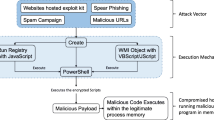Abstract
The paper points out that the deep reason why modern computer system fails to defense malware lies in that user has no right to control the access of information, and proposes an explicit authorization mechanism. Its basic idea is that user explicitly authorizes program the file set it can access, and monitor all file access operations; once program requests to access file out of the authorized file set, refuse it, and this means that the program is malicious or has design errors. Computers based on this novel mechanism can protect information from attacking reliably, and have good software and hardware compatibility. A testing system is presented to validate our theory.
Similar content being viewed by others
References
Cohen F. Computer Viruses-Theory and Experiments [C]//7th DoD/NBS Computer Security Conf, Gaithersburg, MD, September, 1984:143–158.
Adelman L. An Abstract Theory of Computer Viruses [C]//Advances in ryptology CRYPTO' 88Proceedings, New York: Springer-Verlag, August, 1988:354–374.
Chess D M, White S R. An Undetectable Computer Virus [C]//Virus Bulletin Conference, Orlando, USA, September, 2000.
Cohen F. Computational Aspects of Computer Viruses [J].Computers and Security, 1989,8(4):325–344.
Bishop M.An Overview of Computer Viruses in a Research Environment [R]. Hanover: Department of Mathematics and Computer Science, Dartmouth College, 1992.
Trilling S, Nachenberg C. The Future of Malware [C]//EICAR 1999Best Paper Proceedings, Aalborg, Denmark, May, 1991:1–28.
Kirovski D, Drinic M, Potkonjak M. Enabling Trusted Software Integrity [C]//Proceedings of ASPLOS-X, San Jose, CA, USA, October, 2002:108–120.
Chang F, Itzkovitz A, Karamcheti V. User-Level Resource-Constrained Sandboxing [C]//Proceedings of 4th USENIX Windows Systems Symposium, Washington, USA, August, 2000:25–36.
Ganger G R, Nagle D F. Better Security via Smarter Devices [C]//IEEE workshop on hot topics in operating systems, Elmau/Oberbayern, Germany, May, 2001:100–105.
Gligor V D. 20 Years of Operating Systems Security [C]//Proceedings of the 1999IEEE symposium on security and privacy, Oakland, California, May, 1999:108–110.
Balzer R, Goldman N. Mediating Connectors: A Non-Bypassable Process Wrapping Technology [C]//Proceedings of the 2000DARPA Information Survivability Conference and Exposition, Los Alamitos, California, USA, January, 2000: 361–368.
Author information
Authors and Affiliations
Corresponding author
Additional information
Foundation item: Supported by the Foundation of National Laboratory for Modern Communications(51436050505KG0101)
Biography: HE Hongjun (1968-), male, Associate professor, Ph. D., research direction: computer security.
Rights and permissions
About this article
Cite this article
Hongjun, H., Li, L., Sihua, C. et al. A method to defend file-attacking. Wuhan Univ. J. Nat. Sci. 11, 1419–1423 (2006). https://doi.org/10.1007/BF02831788
Received:
Issue Date:
DOI: https://doi.org/10.1007/BF02831788




